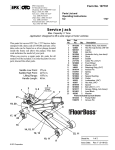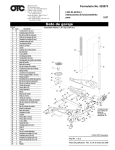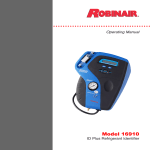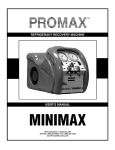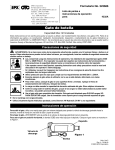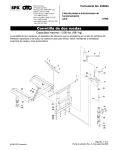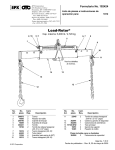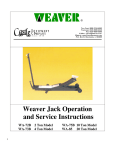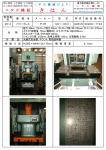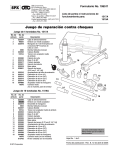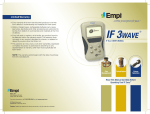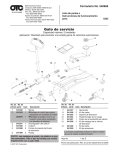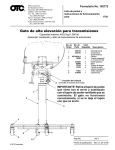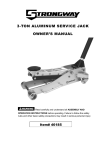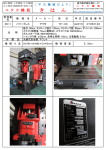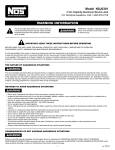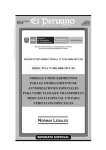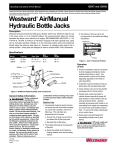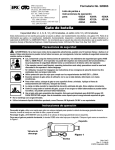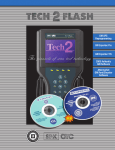Download Air / Hydraulic Long Reach Axle Jack
Transcript
SPX Corporation 655 Eisenhower Drive Owatonna, MN 55060-0995 USA Phone: (507) 455-7000 Tech. Serv.: (800) 533-6127 Fax: (800) 955-8329 Order Entry: (800) 533-6127 Fax: (800) 283-8665 International Sales: (507) 455-7223 Fax: (507) 455-7063 Form No. 107273 Parts List and Operating Instructions for: 5093 5094 Air / Hydraulic Long Reach Axle Jack Max. Capacity Per Stage: 5093 - 20/40/60 Ton 5094 - 14/25/40/60Ton Safety Precautions CAUTION: To prevent personal injury and damage to equipment, • Read, understand, and follow all instructions, including ASME PALD Part 10 for service jacks. If the operator cannot read English, operating instructions and safety precautions must be read and discussed in the operator’s native language. Si el operador no puede leer el inglés, las instrucciones de operación y las precauciones de seguridad deberán leerse y comentarse en el idioma nativo del operador. Si l’utilisateur ne peut lire l’anglais, les instructions et les consignes de sécurité doivent lui être expliquées dans sa langue maternelle. • Before using the service jack to lift a vehicle, refer to the vehicle service manual to determine recommended lifting surfaces on the vehicle chassis. • Wear eye protection that meets ANSI Z87.1 and OSHA standards. • Ensure that there are no passengers in the vehicle to be lifted. • Inspect the jack before each use; do not use the jack if it’s damaged, altered, or in poor condition. Take corrective action if any of the following conditions are found: cracked or damaged housing; excessive wear, bending, or other damage; leaking hydraulic fluid; scored or damaged piston rod; loose hardware; modified or altered equipment. • Maintain correct air pressure, and keep the air hose away from hot or sharp edges. • The load to be lifted must never exceed the rated capacity of the jack. • • Never operate the jack beyond the maximum stroke indicated on the label. Use the jack on a hard, level surface. The jack must be free to roll without any obstructions while lifting or lowering the vehicle. The wheels of the vehicle must be in the straight-ahead position, and the hand brake released. • Use the jack for lifting purposes only. Do not use it for the purpose of moving a vehicle. Stay clear of a lifted load. Place support stands under the axles before working on the vehicle. • Center the load on the jack saddle. Off-center loads can damage seals and cause jack failure. Lift only dead weight. • Do not use blocks or other extenders between the saddle and the load being lifted. • • Do not modify the jack or use adapters unless approved or supplied by OTC. • Lower the jack slowly and carefully while watching the position of the jack saddle. • Use only approved hydraulic fluid (Chevron AW Hydraulic Oil or equivalent). The use of alcohol, hydraulic brake fluid, or transmission oil could damage seals and result in jack failure. The jack is fitted with an overload valve, which is factory set. Do not tamper with this valve. This guide cannot cover every situation, so always do the job with safety first. Sheet No. © SPX Corporation 1 of 3 Issue Date: Rev. C 10-02-2002 Parts List & Operating Instructions Form No. 107273, sheet 1 of 3, back 8 3 3 3 8 7 7 f 5 f f f 3 5 4 3 3 5 4 5 1 1 1 1 5 f 1 5 5 f 1 1 5 1 1 1 1 1 1 5 4 9 1, f 1 1 1 1 1 1 12 1, f 1 1 12 1, f 1 4 1, f 1 1 1 1 12 1 12 f 1, f 9 f f 1, f 1, f 1 1 1 1 1 f 1 1 1 1 1 1, f 1 1 1 4 1 11 1 2 2 1 1 1 2 1 f f f 2 10 6 6 (Includes both wheels) 6 6 Replacement Kits Item No. Part No. 1 515339 515350 515340 515351 515341 515342 515343 515344 515345 2 3 4 5 6 7 Description Replacement Air/Hydr. Pump (5093 only) Replacement Air/Hydr. Pump (5094 only) Hydraulic Reservoir (5093 only) Hydraulic Reservoir (5094 only) Release Valve Assembly Replacement Tubes Replacement Handle Wheel/Axle Assembly Replacement Release Valve Cover Item No. Part No. 8 515346 515352 515347 515348 515349 515353 9 10 11 12 f Description Replacement Cover (5093 only) Replacement Cover (5094 only) Replacement Handle Stop Bolt Replacement Extension Seal Repair Kit (5093 only) Seal Repair Kit (5094 only) Items included in 5093 and 5094 Seal Repair Kits Parts List & Operating Instructions Form No. 107273 Setup 1. Remove the base cover. 2. Remove the zinc-coated rod “A,” and connect the blue plastic tube (supplied). Base Cover "A" Figure 1 Note: Disengage the trigger lever to lock the handle in one of four positions: 1. 2. 3. 4. 2 collapsible for transport and packing storage position displacement position working or horizontal position 3 1 4 Figure 2 3. Place the handle in Position 4, and assemble the bolt and floor stop under the upper side of the handle plate. Floor Stop 4. Install the base cover. Bolt Figure 3 Sheet No. © SPX Corporation 2 of 3 Issue Date: Rev. C 10-02-2002 Parts List & Operating Instructions Form No. 107273, sheet 2 of 3, back Operating Instructions 1. Move the control lever to the OFF position. 2. Connect the air supply. Recommended air pressure is 100 – 145 PSI (7 – 10 BAR). The shop air line must have an air filter/lubricator unit; water in the air line will damage the jack. Note: Air can accumulate within a hydraulic system during shipment or after prolonged use. This entrapped air causes the jack to respond slowly or feel “spongy.” To remove the air: A. Push the control lever DOWN, and hold it there for a few seconds. B. Push the control lever UP to effect a complete lifting cycle. C. Push the control lever DOWN to retract the jack pistons. (The pistons should react in a smooth motion. If not, repeat Steps A – C.) 3. Push the control lever UP to raise the saddle to the contact point. 4. Check the placement of the jack; the load must be centered on the jack saddle. IMPORTANT: Avoid wheel obstructions such as gravel, tools, or uneven expansion joints. 5. Finish lifting the vehicle. Do not attempt to raise the jack beyond its travel stops. 6. Place approved support stands under the vehicle’s lifting points (points recommended by vehicle manufacturer) that will provide stable support. Before making repairs on the vehicle, lower it onto the support stands by SLOWLY and CAREFULLY pushing the control lever DOWN. Preventive Maintenance IMPORTANT: The greatest single cause of failure in hydraulic units is dirt. Keep the service jack clean and well lubricated to prevent foreign matter from entering the system. If the jack has been exposed to rain, snow, sand, or grit, it must be cleaned before it is used. 1. Store the jack with the pistons completely retracted in a well-protected area where it will not be exposed to corrosive vapors, abrasive dust, or any other harmful elements. 2. Always use original parts to avoid damage to the jack. 3. Regularly lubricate the moving parts in the wheels, arm, and handle. 4. Replace the oil in the reservoir at least once per year. To check the oil level, lower the jack pistons completely. The oil level should be between the two marks on the dipstick. If necessary, add approved anti-wear hydraulic jack oil, and install the dipstick again. IMPORTANT: The use of alcohol, hydraulic brake fluid, or transmission oil could damage the seals and result in jack failure. Use only HL or HM type hydraulic oil with an ISO viscosity grade of 22 or SAE viscosity grade of SW. 5. Inspect the jack before each use. Take corrective action if any of the following problems are found: a. cracked, damaged housing b. excessive wear, bending, other damage c. leaking hydraulic fluid d. scored, damaged piston rod e. loose hardware f. modified equipment 6. Keep warning labels and instructional decals clean and readable. Use a mild soap solution to wash external surfaces of the jack. Parts List & Operating Instructions Form No. 107273 Troubleshooting Guide Repair procedures must be performed in a dirt-free environment by qualified personnel who are familiar with this equipment. CAUTION: All inspection, maintenance, and repair procedures must be performed when the jack is free of a load (not in use) and disconnected from the air supply. Trouble Jack does not lift Cause Solution 1.Control valve in wrong position. 1.Move control valve to UP position. 2.Low/no oil in reservoir. 2.Fill with oil and bleed system. 3.Air-locked system. 3.Bleed system. 4.Load is above capacity of jack. 4.Use correct equipment. 5.Delivery valve and/or bypass valve not working correctly. 5.Clean to remove dirt or foreign matter. Replace oil. 6.Packing worn out or defective. 6.Replace hydraulic unit. Jack lifts only partially 1.Too much or not enough oil. 1.Check oil level. Jack advances slowly 1.Pump not working correctly. 1.Replace hydraulic unit. 2.Leaking seals. 2.Replace hydraulic unit. Jack lifts load, but doesn't hold 1.Cylinder packing is leaking. 1.Replace hydraulic unit. 2.Valve not working correctly (suction, delivery, release, or bypass). 2.Inspect valves. Clean and repair seat surfaces. 3.Air-locked system. 3.Bleed system. Jack leaks oil 1.Worn or damaged seals. 1.Replace hydraulic unit. Jack will not retract 1.Control valve in wrong position. 1.Move control valve to DOWN position. Jack retracts slowly 1.Cylinder damaged internally. 1.Send jack to OTC-authorized service center. (Refer to OTC Form No. 104031.) Sheet No. © SPX Corporation 3 of 3 Issue Date: Rev. C 10-02-2002





